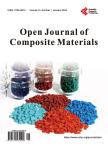Prediction of the Enhanced Out-of-Plane Thermal Conductivity of Carbon Fiber Composites Produced by VARTM
Prediction of the Enhanced Out-of-Plane Thermal Conductivity of Carbon Fiber Composites Produced by VARTM作者机构:Institut für Kunststofftechnik Westpfalz University of Applied Sciences Kaiserslautern Pirmasens Germany
出 版 物:《Open Journal of Composite Materials》 (复合材料期刊(英文))
年 卷 期:2016年第6卷第4期
页 面:100-111页
学科分类:08[工学] 0805[工学-材料科学与工程(可授工学、理学学位)] 080502[工学-材料学]
主 题:Thermal Conductivity Vacuum Assisted Resin Transfer Molding (VARTM) 3D-Weaving Modeling Woven Fabric Composites
摘 要:The thermal conductivity of epoxy resin can be increased by a factor of eight to ten by loading with highly conductive particles. However, higher loadings increase the viscosity of the resin and hamper its use for liquid composite molding processes. Thus, the enhancement of the out-of-plane thermal conductivity of carbon composites manufactured by VARTM and accomplished by matrix filling is limited to about 250%. In order to derive higher increases in out-of-plane thermal conductivity, additional measures have to be taken. These consist of introducing thermally conductive fibers in out-of-plane direction of the preform using a 3D-weaving process. Measured out-of-plane thermal conductivities of 3D-woven fabric composites are significantly increased compared to a typical laminated composite. It has been shown that if introducing highly conductive z-fibers, the use of a particle filled resin is not necessary and furthermore should be avoided due to the manufacturing problems mentioned above. An existing analytical model was altered to predict the effective thermal conductivity as a function of the composite material properties such as the thermal conductivities and volume contents of fibers in in-plane and out-of-plane directions, the thermal conductivity of the loaded resin, the grid-density of the out- of-plane fibers, and material properties of the contacting material. The predicted results are compared with measured data of manufactured samples.



